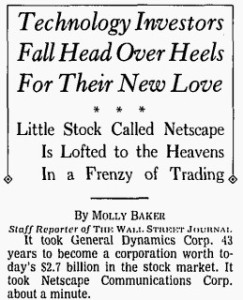The year 1995 was filled with decisive turns and memorable developments; among them, the “Netscape Moment” of 25 years ago. It was an eye-popping moment in an exceptional year.
 On August 9, 1995, Silicon Valley startup Netscape Communications made its stunning market debut and effectively illuminated the emergent World Wide Web for millions of people who, until then, were only vaguely familiar with its potential and promise.
On August 9, 1995, Silicon Valley startup Netscape Communications made its stunning market debut and effectively illuminated the emergent World Wide Web for millions of people who, until then, were only vaguely familiar with its potential and promise.
Netscape’s initial public offering of shares stimulated the dot.com boom of the late 1990s and enabled what has been called “the technological, social, and financial tone of the Internet age.”
Even more flattering was Brian McCullough, who wrote in his 2018 book, How the Internet Happened:
“There are occasionally events that signal the arrival of a new force in culture (say, the Beatles on The Ed Sullivan Show) or serve as the demarcation line between historical eras (September 11, 2001, for example). The Netscape IPO was just such a moment in time.”
Netscape was the internet start-up from central casting. It had a poetic, pitch-perfect name, and it exuded panache at a time when it was fine to be a bit brash and expansive about the Web. The company’s IPO was nothing if not brash, signaling as it did that the Web could be a place to make fortunes.
Netscape was the maker of the breakthrough Web browser, Navigator. By summer 1995, Navigator commanded more than 70 percent of the emergent browser market. For millions of people, Navigator was the gateway to the early Web.
Even though Netscape had yet to turn a profit, the company 25 years ago on August 9 placed 5 million shares of its stock for sale on NASDAQ, priced at $28 per share.
For nearly two hours that morning, an order imbalance kept the company’s shares from being traded: Demand was that strong. Finally, the stock opened — at $71 per share. It climbed as high as $74.75 a share before settling at day’s end to $58.25.
The Wall Street Journal noted that it had taken General Dynamics 43 years to become a corporation worth $2.7 billion in the stock market. It had taken Netscape “about a minute.”
(The New York Times, on the other hand, sniffed that all the excitement surrounding Netscape seemed “a little, well, juvenile.”)
The IPO made millions for the company’s founders, which only added to Netscape’s allure.
The Netscape shares of Jim Clark, already wealthy from having founded Silicon Graphics, was worth about $566 million at the close of trading on August 9. Netscape’s other founder, 24-year-old Marc Andreessen, had a stake valued at nearly $59 million.
Andreessen was the defining and, in a way, the most improbable figure of the Netscape story. He was less than two years out of college in 1995 and he had not shed all the eccentricities of undergraduate life, as I wrote in my book, 1995: The Year the Future Began. He worked late and got up late. His taste in clothes, it was said, ran to “frat-party ready.”
Andreessen seemed the embodiment of the Internet-geek-as-luminary. Nick Gillespie, the brilliant editor-at-large of Reason magazine. once noted:
“If Jim Morrison was the ultimate, first real rock star, Andreessen was the first real Web star.”
At the end of 1995, Newsweek magazine referred to Andreessen, now a prominent venture capitalist in Silicon Valley, as “the über-super-wunder whiz kid of cyberspace” whose “programming savvy has turned the Internet’s World Wide Web into an electronic playground that is revolutionizing information technology and the ever-growing global network of computers.”
Andreessen could be provocatively colorful. He dismissed the technical qualities of Microsoft’s Windows operating software. He likened the conduct of representatives of Microsoft Corporation to “a visit by Don Corleone” of The Godfather films.
“I expected to find a bloody computer monitor in my bed the next day,” he said of a meeting with Microsoft at Netscape’s headquarters in June 1995.
At that meeting, Microsoft delivered what Netscape regarded as a heavy-handed threat: Divvy up the market for Web browsers or face the prospect of annihilation.
Microsoft was then developing a Web browser, the anemic first version of Internet Explorer, which the company bundled with some versions of its Windows 95 operating software. Windows 95 was released in late August 1995 amid much hype and contrived hoopla.
By year’s end 1995, Netscape was locked in a “browser war” with Microsoft.
It was a death struggle for Netscape, as later versions of Internet Explorer were technically as good as Netscape’s subsequent editions of Navigator.
Netscape steadily lost share of the browser market and in November 1998, it was acquired by AOL.com in a deal eventually worth $10 billion. The acquisition was completed in 1999.
Ironically, “Netscape” and its contributions have slowly been slipping from collective memory.
And therein lies another reason why Netscape deserves to be remembered, years after it burst into prominence: Netscape can be regarded as an early victim of the Web’s ruthlessness, crushed by Microsoft and the predatory strategies it employed in the “browser war” — strategies later found to be illegal restraints of trade.
But 25 years ago, Netscape and its IPO “brought the Web into popular consciousness,” as I write in 1995. And its browser, I added, “signaled the centrality of the Web in the digital age.”
- How important was Netscape?
- When the Web was new: Remembering Netscape, its contributions, its fall
- ‘1995 was watershed moment,’ says Intel CEO
- Hype and hoopla in a watershed year: Launching Windows 95
- 20 years after its launch Amazon, showing an unlikable side
- Anniversaries, controversies for Amazon.com
- Recalling the ‘coolness’ of the early Web
- Saluting the unassuming wiki, 20 years after its launch
- Talking Internet history, and 1995
- Why 1995?



















